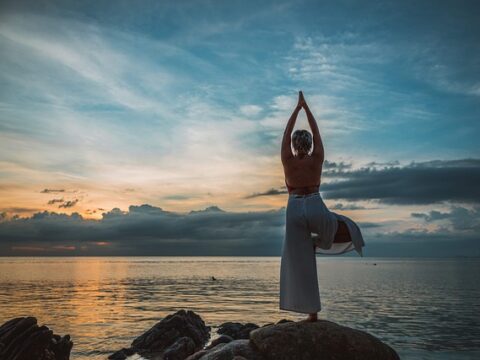SUP Yoga, or Stand Up Paddle Board Yoga, has gained popularity in recent years. It’s a fun and challenging way to get a great workout while enjoying the outdoors. If you’re looking for a challenging workout that also gets you out in the fresh air, SUP yoga (stand up paddle boarding yoga) might be for you. In this article, you’ll learn about the benefits of stand-up paddleboarding yoga, what you need to do it and popular yoga exercises to try.
Podcast
What is SUP yoga?
SUP yoga is the practice of learning the traditional yoga poses, but adding the added challenge of standing up on a board. While SUP yoga isn’t exactly new, it has been growing in popularity for the past few years. Nowadays, there are classes available at local gyms, and even several online courses that are designed to teach you how to do this.
What are the benefits of SUP yoga?
The benefits of SUP yoga include the physical benefits of yoga, the mental benefits of yoga and some benefits that may surprise you.
SUP yoga activates new muscles
If you’re an active person who enjoys the outdoors, SUP yoga is a great option. The main benefit of SUP yoga is that it requires a lot of balance and coordination, this will engage new muscles. This means that anyone who struggles with these activities will probably enjoy it.
A new kind of workout
I don’t know about you, but I get bored quickly when it comes to working out. That’s why I love finding new ways to cross train and change up my routine. It challenges my body in new ways and uses different muscles while resting others that are used more frequently. It’s also a great way to add variety and keep me motivated.
SUP yoga is a great cross-training because it is so different from all other forms of exercise. It requires good balance and concentration, challenges you in new ways and helps you improve your fitness and recovery at the same time.
Less stress
Traditional exercise combined with yoga can be particularly effective at reducing stress. This is because yoga can help you focus on deep breathing, which in turn promotes the release of endorphins and slows the release of stress hormones.
Although it can be frustrating at first not being able to perform a pose perfectly, you will eventually feel less stressed by the activity.
Better balance
In summary, stand up paddle boarding improves your balance, as does yoga. If you combine these two activities, your balance will improve significantly.
Improves technique
Another benefit of SUP yoga is that it improves your yoga practice on land. If you can perform the yoga exercises in the middle of the water on a stand up paddle board, they will also come easily to you in your daily practice.
If you enjoy yoga and want to improve your techniques, try yoga on the water. You’ll be surprised how much easier it is to perform yoga poses on land after you’ve practised in the water.
Sharpen your focus
Although SUP yoga can be difficult, it’s also a great way to work on your focus.
Safety tips for stand-up paddle board yoga
So if you’re thinking of learning to stand up on a SUP, there are a few things you should keep in mind to stay safe.
First of all, you should always wear a life jacket. It will save you if you get into trouble and go overboard, and it will also keep you afloat.
If you are using a SUP board with skimmers, make sure your feet are pointing backwards. This will prevent you from capsizing. Also make sure that the board is not tilted too much. This will make you unstable and you may fall over.
Next, you should pay attention to the weather. If the water is too cold, it will be harder for you to get up. So check the weather forecast before you go out and do not go out if there is a risk of rain.
Another thing to keep in mind is that if you are going to practice on the sea, you should check if there are sharks out there. When the water gets murky, sharks are more likely to attack. So stay close to the shore and be alert.
Finally, it’s always good to talk to your instuctor before you go out. He can give you some tips on what to do if you get into trouble or capsize.
12 Paddleboard Yoga Postures for Beginners
Stretching the shoulders
To understand yoga better, I thought we should look at some yoga shoulder stretches. What are they? Why do you need them? How do you do them? And is it really worth it? Let’s go through these questions and find out.
Why should you stretch your shoulders?
Did you know that people in general, and older people in particular, tend to have weaker shoulders? While this is probably not a problem for you, it can cause problems for people who do a lot of lifting. If you regularly lift heavy objects, you may want to think about stretching your shoulders.
People with weak shoulders often get shoulder injuries like rotator cuff tears. These are injuries that can cause pain, weakness and even numbness in your arm.
As we get older, our shoulders naturally become thinner and weaker, which can lead to poor posture. Poor posture can lead to shoulder pain and injury. So the sooner you stretch your shoulders, the less likely you are to develop problems.
How to do yoga shoulder stretches
You can do yoga shoulder stretches in any position that suits you. However, most people choose to do them in a standing position because that is where they stay the longest and because that is where you will see the results.
The first step in all yoga shoulder stretches is to keep your arms straight.
Now slowly raise your arms upwards, keeping them straight. You should find that your shoulders are higher than your arms. Once you have reached this position, you should hold it for 10 seconds.
Then slowly lower your arms again while continuing to stretch your shoulders. Repeat this stretch several times, trying to keep your arms straight.
Remember that as you get stronger and more flexible, you can use a bent arm to avoid stretching your shoulders too much.
Hip stretches and leg stretches
In the yoga world, there are two main poses that everyone knows: downward facing dog and warrior pose.
These two poses are the most popular in the yoga world, but there are dozens more poses we can practice to improve our flexibility and overall health.
Leg stretch
First stand on your left foot and then move your right foot behind you so that your right leg is straight.
Then place your right hand on the outside of your right foot and slowly bend forward, keeping your back straight.
As you continue to bend forward, you can either hold onto your foot with your right hand or place your right hand on the floor.
Once you have reached the desired position, hold on for a few seconds before returning to standing.
Repeat the exercise on the other side.
Hip stretch
First stand on your left leg and then slowly turn your left foot outwards so that your left leg is facing away from you.
Then place your left hand on the outside of your left foot and slowly bend forward, keeping your back straight.
As you continue to bend forward, you can either hold onto your foot with your left hand or place your left hand on the floor.
Once you have reached the desired position, hold for a few seconds before returning to standing.
Repeat the exercise on the other side.
Triangle pose
In this pose, raise your hands above your head and stretch your body. Lie on your stomach and rest your hands and knees on the floor. Lift your left leg off the floor and raise your right hand above your head.
Raise your head and look towards your right hand. You can also raise your left arm and touch your right arm. Hold this posture for 20 seconds and repeat this movement twice more.
The child’s pose
To do the child’s pose on a SUP yoga day, first sit down and bend over so that the big toes of your feet touch the bottom of the paddle. Support your hips on your heels and then slowly bring your hands forward until you are at shoulder height. Rest your forehead on the paddle board and you should feel a stretch in your back and neck. Hold the child’s pose for 15 seconds.
Forward Bend
In this pose, lie flat on the floor and bring your knees to your chest. Now place your hands behind your head and slowly lift your chest towards the ceiling. Hold this position for 10 seconds and repeat the movement two more times.
Standing Forward Bend
For this pose you need to stand straight, then bend forward and place your hands on the floor behind you. Your knees bend and you slowly lower your chest to the floor. Make sure your feet are in line with your hips and hold this position for 10 seconds.
Bridge pose
For the bridge pose, lie on the back of your paddleboard with your chest facing up. Bend your knees and lift your hips to form a bridge, using your hip flexors. Hold this bridge position for a few seconds to work your glutes.
Side stretches
Lie on your left side and rest your head on your hand. Place your right hand on the floor and slowly lift your right leg off the floor. You can also lift your head and place it on the floor. You can also try lifting your right leg up and touching your head. Hold this pose for 20 seconds and repeat the movement three times.
Downward facing dog
Start in downward facing dog with your feet together and your hands touching the floor. Then lift the left foot off the floor and lower it towards the floor. Then lift the right foot off the floor and bring it close to your left leg. Continue lifting each foot in turn until your feet are in line with your knees.
Upward facing dog
This pose is usually performed on a mat or firm surface. Lie on the floor and place your hands behind your head. Slowly raise your legs and push your hips away from your knees. Your elbows should stay close to your sides and your fingers should face each other. You can also lift your head slightly off the floor. Hold this position for 20 seconds and repeat the movement three more times.
Warrior
Start standing and place your feet shoulder-width apart. Bend your left knee slightly and extend your right hand towards your right foot. Then lift your right foot off the floor and let your weight fall towards your right hand. Keep your left arm extended, feet in line with your knees and hips facing forward.
Shoulder stand
Start standing with your hands on your hips and your feet together. Then bend your right knee and place your right foot on the floor. Bring your right knee to your chest and your left hand to your right foot. Continue to bring your knee to your chest and repeat the exercise until you feel comfortable.
Exercise tips for the yoga poses on the paddle board
How to get started? Before you get started, you need to get your equipment ready. If you’ve never paddled before, you’ll need a paddle board, a yoga mat, some floaties and a towel.
The first thing you need to do is buy your equipment. It is important to know that if you rent your equipment, you cannot use it for anything other than paddling. So when you buy your equipment, make sure you choose a quality product that will last.
Once you have your equipment ready, you are ready to go. When paddleboarding, you will most likely be using your hands to move around. This means that you will need to push off the paddleboard to move forward.
As you will notice, each pose has its own form of pushing off. So if you don’t know which form of pushing off to use, it is best to just use your hands. However, if you are not sure how to do a particular pose, you can always ask someone who has tried it before. They can give you a better idea of what to do.
Once you have figured out the shape of the push-off, it is now time to move. The first movement you should perform is the jump. While you are jumping, you should keep your head up. This will prevent you from falling into the water. Once you have landed, you should use your paddle board to keep your balance above the water. Once you have found your balance, you should move forward with your arms.
As you move along, you will find that there are many different types of movements you can do. So if you don’t know which one to use, you can just ask someone who has experience. As long as you are confident, there is nothing wrong with trying a new movement every now and then.




